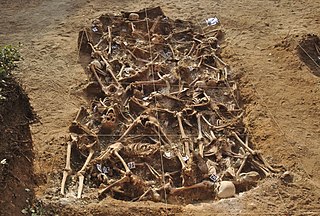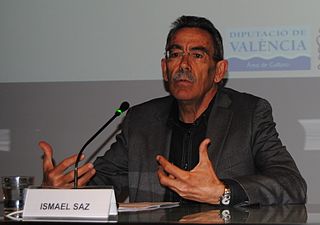Related Research Articles

Francoist Spain, also known as the Francoist dictatorship, was the period of Spanish history between 1936 and 1975, when Francisco Franco ruled Spain after the Spanish Civil War with the title Caudillo. After his death in 1975 due to heart failure, Spain transitioned into a democracy. During Franco's rule, Spain was officially known as the Spanish State.

Numerous internment camps and concentration camps were located in France before, during and after World War II. Beside the camps created during World War I to intern German, Austrian and Ottoman civilian prisoners, the Third Republic (1871–1940) opened various internment camps for the Spanish refugees fleeing the Spanish Civil War (1936–1939). Following the prohibition of the French Communist Party (PCF) by the government of Édouard Daladier, they were used to detain communist political prisoners. The Third Republic also interned German anti-Nazis.

In the history of Spain, the White Terror describes the political repression, including executions and rapes, that was carried out by the Nationalist faction during the Spanish Civil War (1936–1939), as well as during the first nine years of the regime of General Francisco Franco. In the 1936–1945 period, Francoist Spain had many officially designated enemies: supporters of the Second Spanish Republic (1931–1939), liberals, socialists of different stripes, Protestants, intellectuals, homosexuals, Freemasons, Jews, and Basque, Catalan, Andalusian, and Galician nationalists.

Law 52/2007, commonly known as Historical Memory Law, recognises and broadens "the rights and establishes measures in favour of those who suffered persecution or violence during the civil war and the dictatorship." It was passed by the Congress of Deputies on 31 October 2007, on the basis of a bill proposed by the PSOE government of Prime Minister José Luis Rodríguez Zapatero. The Historical Memory Law principally recognizes the victims on both sides of the Spanish Civil War, gives rights to the victims and the descendants of victims of the Civil War and of the subsequent dictatorship, and formally condemns the repressions of the Franco regime.

Antonio Vallejo-Nájera (1889–1960) was a Spanish psychiatrist. He was interested in eugenics and proposed a link between Marxism and intellectual disability, something he sought to prove through experimenting on Republican prisoners. His ideas led to the thefts of many Spanish newborns and young children from their left-wing parents in Francoist Spain; as many as 30,000 children were taken from leftist families and placed with nationalist families. Vallejo-Nájera was rewarded for his assistance during the Spanish Civil War and he became a leading figure in Spanish psychiatry.

The General Archive of the Spanish Civil War is a specialist archive containing material related to the Spanish Civil War. It is part of Spain's National Historical Archive and is located in Salamanca.

In Francoist Spain, at least two to three hundred concentration camps operated from 1936 until 1947, some permanent and many others temporary. The network of camps was an instrument of Franco's repression.
The lost children of Francoism were the children abducted from Republican parents, who were either in jail or had been assassinated by Nationalist troops, during the Spanish Civil War and Francoist Spain, and later from random citizens or girls confined in the notorious Women's Protection Board. The kidnapped children were sometimes also victims of child trafficking and forced adoption.

Antonio Azarola y Gresillón was a Spanish Navy officer, rear admiral of the Spanish Republican Navy. He was executed by firing squad on 4 August 1936 at the Ferrol Naval Base in Galicia, NW Spain, by rebel Navy officers for refusing to join the coup of July 1936 against the Spanish Republic that triggered the Spanish Civil War.

Sociological Francoism is an expression used in Spain which attests to the social features of Francoism that lingered in Spanish society after the death of Francisco Franco in 1975 and continue to the present day.
Carlota Alejandra Regina Micaela O'Neill y de Lamo was a Spanish writer and journalist. Her husband, Captain Virgilio Leret Ruiz, was executed after opposing the July 1936 military uprising in Melilla which led to the Civil War. She spent three years and nine months in prison and some years later went into Venezuela and Mexico. She also wrote under the pseudonyms Carlota Lionell and Laura de Noves.
In the history of Spain, the White Terror was the series of assassinations realized by the Nationalist faction during the Spanish Civil War (1936–1939), and during the first nine years of the régime of General Francisco Franco. Thousands of victims are buried in hundreds of unmarked common graves, more than 600 in Andalusia alone. The largest of these is the common grave at San Rafael cemetery on the outskirts of Málaga. The Association for the Recovery of Historical Memory says that the number of disappeared is over 35,000.

Women prisoners in Francoist Spain were often there because of specific repression aimed at women. During the Civil War, many women were in prison because family members had Republican sympathies or the authorities wanted to lure out male Republican affiliated relatives; it was not a result of anything the women did themselves. The Law of Political Responsibilities, adopted on 13 February 1939, made such repression easier and was not formally removed from the Criminal Code until 1966. Prisoners and people in concentration camps, both male and female, would total over three quarters of a million by the end of the Spanish Civil War. Of these, 14,000 women were held in the Las Ventas Model prison in Madrid.
Women in POUM in Francoist Spain were few as many, along with male dominated leadership, were forced into exile following the end of the Spanish Civil War. Those in exile often felt isolated and alone. Those who remained were sometimes sent to prison. POUM women participated in a hunger strike at Madrid's Las Ventas prison in 1946. The group fell by the wayside as Partido Comunista de España became the pre-dominant resistance organization in Spain. The organization finally dissolved during the 1950s in Toulouse, France with its memory kept alive by the wife of its last president, María Teresa Carbone, through the Fundació Andreu Nin.

Gender violence and rape in Francoist Spain was a problem that was a result of Nationalist attitudes developed during the Spanish Civil War. Sexual violence was common on the part of Nationalist forces and their allies during the Civil War. Falangist rearguard troops would rape and murder women in cemeteries, hospitals, farmhouses, and prisons. They would rape, torture and murder socialists, young girls, nurses and milicianas.
Women in 1940s Spain were mainly recognised as mothers.

Ismael Saz Campos is a Spanish historian, specialised in the study of Falangism, Francoist Spain and the Spanish-Italian relations during the Spanish Civil War. He is a professor at the University of Valencia.
The Board for the Protection of Women or Women's Protection Board was a public institution in Francoist Spain, established in 1941 under the Ministry of Justice. Notorious for its human rights violations, baby abductions, and brutality, the Board targeted girls and young women, confining them in reformatories as part of the broader Francoist repression. It persisted during the democratic Transition and wasn't eventually dismantled until well into the first government of Felipe González.
Esteve Conrad Francesc Pallarols Xirgu was a Catalan anarchist who became the first General Secretary of the CNT in clandestinity after the end of the Spanish Civil War. He organised the release of anarchist prisoners from Francoist concentration camps and their subsequent escape from Spain, for which he was executed by the Francoist authorities.
References
- ↑ "What lies beneath". Financial Times. 10 November 2007. Retrieved 25 October 2017.
- ↑ The Splintering of Spain, pp. 2–3 Cambridge University Press, ISBN 978-0-521-82178-0
- ↑ Juliá, Santos (24 November 2008). "El primer gran movimiento unitario de la oposición, tras la muerte de Franco, fue exigir la libertad de los presos políticos como irrenunciable primer paso a la democracia. Los logros no obligaron a olvidar el pasado". El País (in Spanish). Retrieved 26 October 2017.
- ↑ (in Spanish) Ley 46/1977, de 15 de octubre, de Amnistia., BOE núm. 248, de 17 de octubre de 1977, páginas 22765 a 22766 (2 págs.). (BOE-A-1977-24937). Accessed online 25 October 2017.
- ↑ "Argentina asks Spain to arrest 20 Franco-era officials". BBC. 1 November 2014. Retrieved 13 November 2017.
- ↑ "Portal de Víctimas de la Guerra Civil y Represaliados del Franquismo" . Retrieved August 29, 2012.
- ↑ "Marcos Ana". 26 November 2016. Retrieved 26 October 2017.